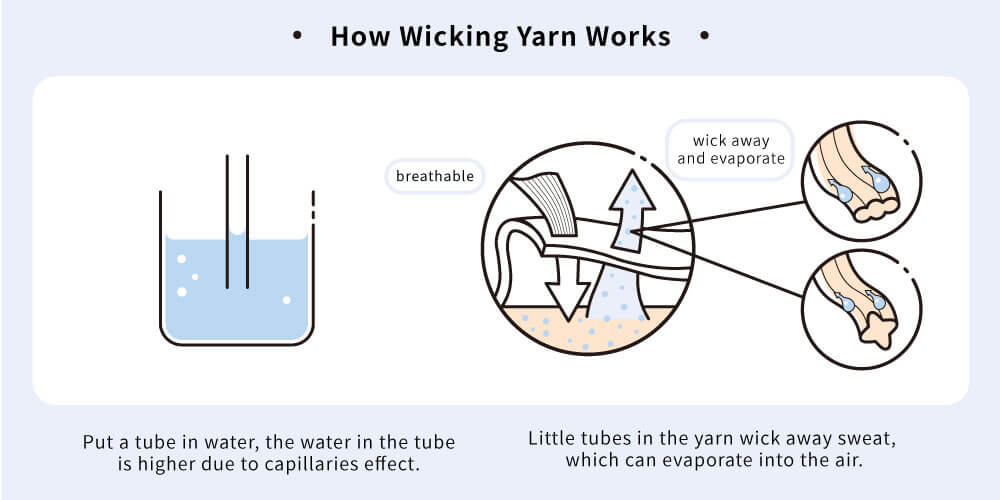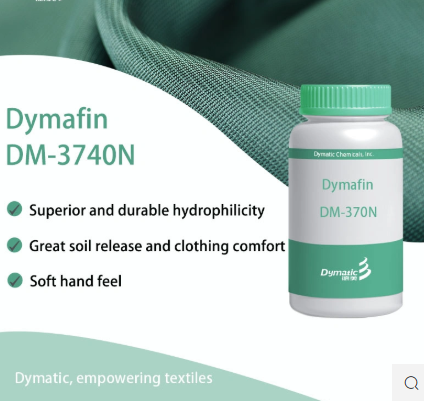
Nowadays, as consumers increasingly choose activewear as their daily outfits, more entrepreneurs are looking to create their own athletic clothing brands in different activewear segments. “Quick-drying”, ”sweat-wicking”and”moisture-wicking”have become essential for clothing manufacturing. With these demand comes a wide variety of available fabrics to choose from. This leads to a problem for activewear beginners: how to select excellent fabrics for their activewear products?

As a professional activewear manufacturer, helping our clients choose the right fabrics with good features is very important for us. Thus, we would like to share you more knowledge and suggestions about quick-dry materials. Hope it can help.
How Does Sweat-wicking Fabric Works?
Before choosing these fabrics, we need to understand how they work on wicking away sweats then vanishing them.
Normally, fabric absorption and evaporation are influenced by 3 factors: the physical structures and chemical compositions of the fibers, the weaving of the textiles and the fabric finishing process. Here are some basic truths of these 3 factors you need to learn.
1. Fiber Structures & Compositions
Fibers can possess moisture-wicking properties through their physical and chemical structures. Both work based on the same principle: absorb moisture→conduct moisture→evaporate, and can be divided in two simultaneous processes as below:
Fibers absorb gaseous moisture→release gaseous moisture through their surfaces→sweats evaporate
Gaps and holes in fibers absorb liquid moisture→capillary action generates and conducts it to fiber’s surface, where the sweats can evaporate.

However, their absorbing strengths are affected by different factors. Regarding chemical structures, hydrophilic groups (such as carboxyl, amide, hydroxyl, and amino groups) in fiber molecules can enhance water affinity, thereby improving moisture absorption, while physical structures mainly depending on their morphological design and shape such as hollow and grooved structures.
2. The Weaving of Textile
Similar to fibers, a textile’s weaving structure, thickness and craftsmanship will affect the fabric’s absorption and evaporation properties.
For example, mesh and multi-layer structures can enhance a fabric’s ability to wick sweats.

3. The Finishing of Fabrics
Unlike the 2 methods we mentioned above, using finishing treatments involves the application of external forces. It mainly uses agents that enhance fiber’s hydrophilicity, that is, by changing fiber surface’s structure to make them more hydrophilic, thus improving their absorption and evaporation properties.

Thus, in fact, these 3 factors relate to fiber’s capillary action. Now here is the question: how to choose fabrics with the appropriate sweat-wicking and evaporating functions?
How to Choose Sweat-wicking & Quick-drying Fabrics?
Actually, this will be much easier once we understand the secret of sweat-wicking fabrics. Therefore, all we need to do is tracing back to its roots. There are 3 vital factors to consider when choosing fabrics: compositions, weight (in grams) and finishing agents. If you want to choose fabrics more outstanding on moisture-wicking, then you might also need to check their weaving, thickness and yarn density. Arabella has summarized you some basic principles of selecting these fabrics as below.
Compositions & Fiber Types
Normally, fabrics with compositions of polyester, nylon (polyamide) , polypropylene and wool can provide excellent performance on wicking moisture. The shape of the fibers plays a role, too.
These compositions are widely used in activewear on the market. For example, Arabella has ever produced several training and running t-shirts made with different compositions we mentioned above.
Weight & Thickness
Most of the time, lighter and sheerer textile perform better at moisture-wicking and evaporating than heavier ones. Typically, we consider fabrics weighing between 150-250 g/㎡ are ideal for quick drying and sweat-wicking. However, this is not a decisive factor.
Finishing Agents
When choosing moisture-wicking and quick dry fabrics with agents, it is important to consider agents’ compatibility with the fabric composition and fiber types, as well as their washing durability, environmental friendliness, non-toxicity and hand feel.
There are several common moisture-wicking agent brands on the market, such as Rudolf, Huntsman, BASF, and more.
Weaving
Knitted fabrics are superior to woven fabrics in moisture-wicking. Although, sometimes woven fabrics can use other methods to enhance this feature.
Yarn density
Yarn density is also related to the textile’s fiber structure. Generally, the more fibers and the lower yarn densities in the fabric, the better its absorption and evaporation. Because more fibers can enhance the efficiency of wicking and evaporation, while lower yarn densities ensure that these fibers have the appropriate shapes and gaps to accelerate this process.
In conclusion, sweat-wicking and quick-drying fabrics are no longer a mystery in the activewear industry today, but selecting them does require a comprehensive assessment and careful consideration.
As a professional manufacturer in activewear producing, Arabella has already established a stable and high-quality supply chain to help our clients source material based on our experience. However, with the rapid changes happening today in the clothing industry, we will continue to stay updated on raw materials and remain open to discussions with you.
Stay tuned and we will update more for you!
https://linktr.ee/arabellaclothing.com
info@arabellaclothing.com
Post time: Apr-28-2025
